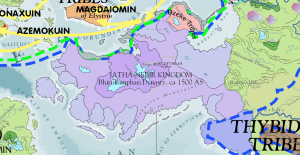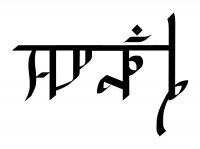Difference between revisions of "Jatha-Nebir Kingdom"
Trismegistus (talk | contribs) m |
Trismegistus (talk | contribs) m |
||
| Line 1: | Line 1: | ||
[[File:HirgunyaScriptJatha-Nebir.png|thumb|200px|The name Jatha-Nebir in Hirgunya Script]] | [[File:HirgunyaScriptJatha-Nebir.png|thumb|200px|The name Jatha-Nebir in Hirgunya Script]] | ||
| + | |||
| + | [[File:Map_Kalama_ca1500AS_01.png|thumb|300px|The extent of the Jatha-Nebir Kingdom under the rule of the [[Bhirukamphan Dynasty]] of roughly the mid second millennium before [[Salmakhamer]]. World of Asdar Screen Capture, ©2024, All Rights Reserved.]] | ||
The last of eleven Kingdoms of Kalama stretching from the [[Flood of Aturyanda]] to the Midrinksi Conquest, the Jatha-Nebir Kingdom lasted from 1729 AS to 1117 AS, a little more than six centuries. Although the last, scholars deem that it was not the weakest and that it endured despite the continual influx of Midrinksi clans into the Corundian Peninsula. The rulers of the Jatha-Nebir Kingdom are divided into seven successive dynasties. Their common seat of residence was ancient Johaulia, then called [[Jhukhaulya]]. The Jatha-Nebir Kingdom succeeded the more famous [[Tamukh Kingdom]] of [[Aturoksha]]. | The last of eleven Kingdoms of Kalama stretching from the [[Flood of Aturyanda]] to the Midrinksi Conquest, the Jatha-Nebir Kingdom lasted from 1729 AS to 1117 AS, a little more than six centuries. Although the last, scholars deem that it was not the weakest and that it endured despite the continual influx of Midrinksi clans into the Corundian Peninsula. The rulers of the Jatha-Nebir Kingdom are divided into seven successive dynasties. Their common seat of residence was ancient Johaulia, then called [[Jhukhaulya]]. The Jatha-Nebir Kingdom succeeded the more famous [[Tamukh Kingdom]] of [[Aturoksha]]. | ||
Revision as of 08:54, 26 August 2024

The last of eleven Kingdoms of Kalama stretching from the Flood of Aturyanda to the Midrinksi Conquest, the Jatha-Nebir Kingdom lasted from 1729 AS to 1117 AS, a little more than six centuries. Although the last, scholars deem that it was not the weakest and that it endured despite the continual influx of Midrinksi clans into the Corundian Peninsula. The rulers of the Jatha-Nebir Kingdom are divided into seven successive dynasties. Their common seat of residence was ancient Johaulia, then called Jhukhaulya. The Jatha-Nebir Kingdom succeeded the more famous Tamukh Kingdom of Aturoksha.
- (Last Kingdom)
- 1729 AS to 1117 AS, (~612 years)
- Non-indigenous to Kshandiguha, rulers come from Jakubya (Lucacia)
- during this time is thought the Kalaman Elephant became extinct.
- The palace was moved back to Jhukhaulya.
- Therya-Prakrip Dynasty, 1729 AS to 1632 AS, (~97 years)
- Ummattha Dynasty, 1631 to 1578 AS, ~54 yrs
- Bhirukamphan Dynasty, 1577 AS to 1405 AS, ~173 yrs
- Karyigha Thaulyagna Dynasty, 1404 AS to 1354 AS, 51 yrs
- Phalumicchurn Dynasty, 1353 AS to 1267 AS, ~87 yrs
- Addhya-Challa Dynasty, 1266 AS to 1164 AS, ~103 yrs
- Phankala
- Chalmudhra
- Zhalayara Kuswa Dynasty, 1163 AS to 1117 AS, ~47 yrs
last rulers pre-Midrinksi rulers of all Kalama, Jatha-Nebirite rulers retained in high valleys of Vimal
Midrinksi invasions (or settlements, depending upon your historical viewpoint) weaken the Zhalayara Kuswa Dynasty which collapses amid internecine conflicts among potential claimants to the throne of the Great Kingship. None is successful and historians regard this as the end of the Jatha-Nebir Kingdom.
- Ambhiru, 1163 to 1151, ~12 yrs
- Ambhiru II, 1151 to 1117, ~34 yrs
See Also
| This article is a stub. It requires further development by the creator. |

